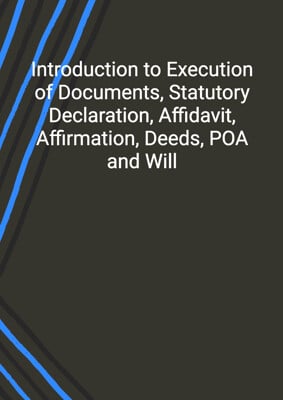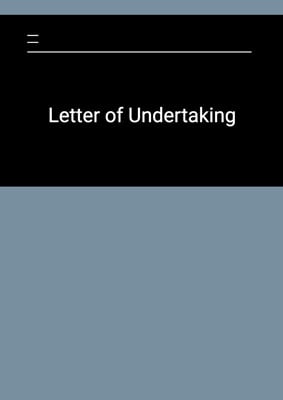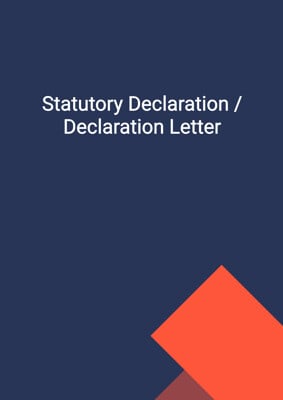How to Tailor the Document for Your Need?
01
Create Document
Click "Create Document" button and the document will be prepared with your account details automatically filled in.
02
Fill Information
Please fill in any additional information by following the step-by-step guide on the left hand side of the preview document and click the "Next" button.
03
Get Document
When you are done, click the "Get Document" button and you can download the document in Word or PDF format.
04
Review Document
Please review the document carefully and make any final modifications to ensure that the details are correct before sending to the addressee.
Document Preview
Document Description
The 'Letter of Undertaking' is a document that serves as a written agreement between two parties, referred to as Party 1 and Party 2. The document is used to outline the terms and conditions of a transaction, specifically regarding the release of money upon completion of the transaction.
The importance of this document lies in its ability to provide a legally binding agreement between the parties involved. It ensures that both Party 1 and Party 2 are aware of their obligations and responsibilities, as well as the consequences of non-compliance. The 'Letter of Undertaking' serves as a form of protection for both parties, as it clearly outlines the terms of the transaction and provides a record of the agreement.
The entire document consists of several sections, each serving a specific purpose. The first section is the introduction, which includes the names and addresses of both parties, as well as the date of the letter. This section sets the context for the document and establishes the identities of the parties involved.
The next section is titled 'Completion Monies'. In this section, Party 2 confirms that they hold a specific sum of money in their bank account, referred to as the completion monies. This money is intended to be paid to Party 1 upon completion of the transaction. The section also outlines the process for releasing the completion monies to Party 1.
Following the 'Completion Monies' section is the 'Interest' section. This section explains how interest earned on the completion monies will be allocated between Party 1 and Party 2. It specifies that interest earned prior to the completion date will be for the account of Party 2, while interest earned after the completion date will be for the account of Party 1. The section also clarifies that if completion does not occur, any interest earned will be for the account of Party 2.
The next section is titled 'Settlement of Completion Monies Following Completion'. This section outlines the steps Party 2 will take to transfer the completion monies, along with any accrued interest for Party 1, to a specified account. It also includes provisions for situations where the monies are placed on overnight or other deposit.
The 'Liability' section states that Party 2 will not be liable for any shortfall in the completion monies or any loss, cost, or liability caused by the actions of banks, financial institutions, or other parties involved in the transaction.
The 'Variation of the Letter' section specifies that any changes to the letter must be made in writing and signed by both parties. This ensures that any modifications to the agreement are documented and agreed upon by both parties.
The 'Severability' section states that if any clause or term in the letter is deemed void or unenforceable, it will not affect the validity of the remaining clauses or terms.
The 'Definitions' section provides definitions for certain terms used throughout the document, such as 'business day' and 'jurisdiction'.
The 'Jurisdiction' section states that the letter will be governed by jurisdiction state law and that any disputes will be settled in jurisdiction state courts.
The final section is the signature block, where Party 2 agrees to the terms of the letter by signing it.
In summary, the 'Letter of Undertaking' is a crucial document that outlines the terms and conditions of a transaction, specifically regarding the release of money upon completion. It provides a legally binding agreement between the parties involved and serves as a record of the agreement.
How to use this document?
To use the 'Letter of Undertaking' effectively, follow these steps:
1. Provide Information: Enter the names and addresses of both parties, Party 1 and Party 2, in the designated fields. This ensures that both parties are clearly identified.
2. Specify Completion Monies: Confirm the amount of money, referred to as the completion monies, that Party 2 holds in their bank account. This amount should be the funds to be paid to Party 1 upon completion of the transaction. Make sure to include the currency and the exact amount.
3. Release of Completion Monies: Party 2 should confirm that upon completion of the transaction, they will cease to hold the completion monies and will proceed to settle the payment to Party 1. This step ensures that the completion monies are transferred to the appropriate party in accordance with the terms of the letter.
4. Understand Interest Allocation: Familiarize yourself with the rules regarding interest earned on the completion monies. Note that interest earned before the completion date will be for the account of Party 2, while interest earned after the completion date will be for the account of Party 1. If completion does not occur, any interest earned will be for the account of Party 2.
5. Settle Completion Monies: After completion, Party 2 should instruct their bank to transfer the completion monies, along with any accrued interest for Party 1, to the specified account. Ensure that this transfer is done as soon as reasonably practicable, preferably before 12:00:00 pm on the business day following the completion date.
6. Consider Deposit Maturity: If completion occurs when the monies are placed on overnight or other deposit, delay sending the transfer instructions until the time and/or day of maturity of the deposit. If the maturity day is not a business day, send the instructions on the next business day.
7. Understand Liability: Be aware that Party 2 will not be liable for any shortfall in the completion monies or any loss, cost, or liability caused by banks, financial institutions, or other parties involved in the transaction.
8. Seek Written Variations: Any changes to the letter must be made in writing and signed by both parties. Ensure that any modifications to the agreement are documented and agreed upon by both Party 1 and Party 2.
9. Familiarize with Definitions: Review the definitions section to understand the meaning of terms used throughout the document, such as 'business day' and 'jurisdiction'. This will help in interpreting the letter accurately.
10. Comply with Jurisdiction: Understand that the terms of the letter will be governed by jurisdiction state law, and any disputes will be settled in jurisdiction state courts. Ensure compliance with the applicable laws and regulations.
By following these steps, you can effectively use the 'Letter of Undertaking' to establish a clear agreement regarding the release of money upon completion of a transaction.
Not the right document?
Don’t worry, we have thousands of documents for you to choose from:








